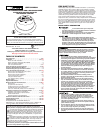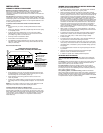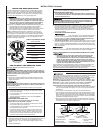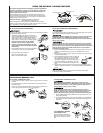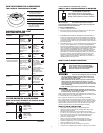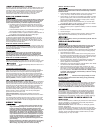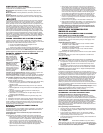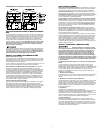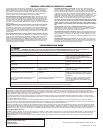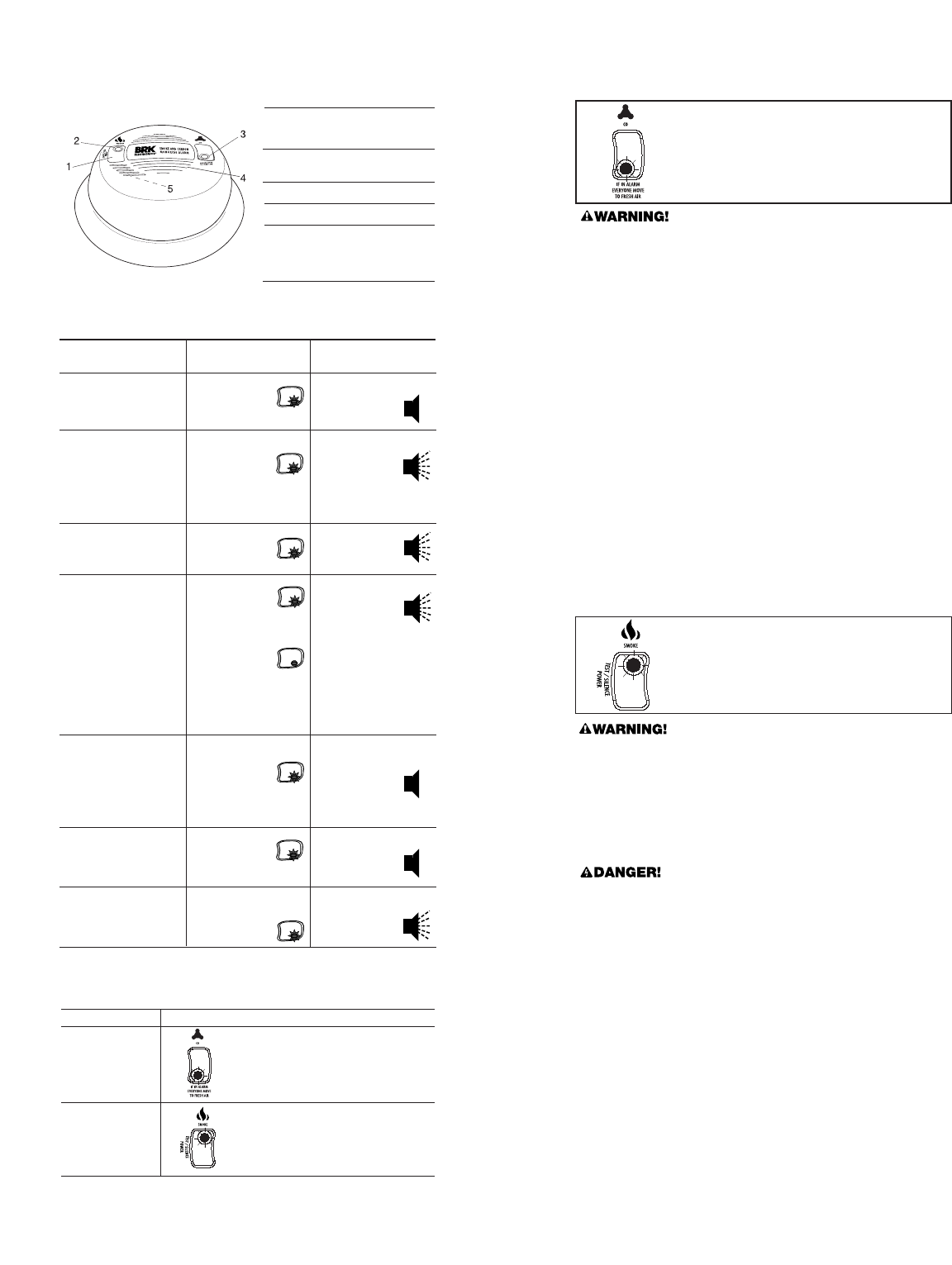
HOW YOUR SMOKE/CO ALARM WORKS
THE COVER OF YOUR SMOKE/CO ALARM
1. Test/Silence Button: Press
and hold to activate test,
or to silence the alarm.
2. POWER Light (GREEN)
SMOKE ALARM Light (RED)
3. CO ALARM Light (RED)
4. Air Vents
5. (Behind the Cover) Alarm
Horn: 85dB audible alarm for
test, alarm, and unit
malfunction warning.
UNDERSTANDING THE LIGHT
AND HORN PATTERNS
Condition LED (Red or Green
Lights)
Horn
POWER UP
Green LED
flashes ON
once, then
shines continuously
Horn remains silent
DURING TESTING
Smoke & CO
Red LEDs flash
once every
second during
their respective
repetitive horn
patterns
Horn pattern:
(Smoke) 3
beeps, pause,
3 beeps,
pause; (CO) 4
beeps, pause, 4
beeps, pause
LOW OR MISSING
BATTERY
Green LED
flashes
(with horn)
Horn “chirps”
about once a
minute
ALARM CONDITION
Interconnected Series
of Smoke/CO Alarms
Smoke or CO
Red LED flashes
rapidly on the
unit that triggered the
alarm.
LEDs on the
other alarms in
an interconnected
series will not flash.
Horn pattern:
(CO) 4 beeps,
pause, 4 beeps,
pause repeating
on all CO Alarms and
“Smart Interconnect”
Alarms;
(Smoke) 3 beeps,
pause, 3 beeps, pause
repeating on all
Smoke, Heat, and
“Smart Interconnect”
Alarms
IN ALARM SILENCE
MODE
Red Smoke or CO
LED flashes
once every
second on
initiating unit
Horn remains silent:
(CO) for 4 minutes;
(Smoke) for up
to 15 minutes.
Horn will sound
if Smoke or CO
levels increase.
“LATCHING” ALARM
INDICATOR
Red Smoke
and/or CO LED
flashes once
every 5 seconds
Horn remains silent
MALFUNCTION
Green LED flashes 3
times synchronized
with 3 rapid
chirps
Horn sounds 3
consecutive
rapid chirps
every minute
IF YOUR SMOKE/CO ALARM SOUNDS
WHAT TO DO FIRST–IDENTIFY THE TYPE OF ALARM
Type of Alarm What You See and Hear
Carbon Monoxide CO Light:
(CO) Flashing RED
Horn: 4 beeps,
pause, 4 beeps,
pause
Smoke Smoke Light:
Flashing RED
Horn: 3 beeps,
pause, 3 beeps,
pause
Continued...
5
IF THE CO ALARM SOUNDS:
1. Operate the Test/Silence button.
2. Call your emergency services, fire department or 911. Write down
the number of your local emergency service here:
_____________________________________________________________
3. Immediately move to fresh air—outdoors or by an open door or
window. Do a head count to check that all persons are accounted
for. Do not re-enter the premises, or move away from the open door
or window until the emergency services responder has arrived, the
premises have been aired out, and your Smoke/CO Alarm remains in
its normal condition.
4. After following steps 1-3, if your Smoke/CO Alarm reactivates within
a 24-hour period, repeat steps 1-3 and call a qualified appliance
technician to investigate for sources of CO from fuel-burning equip-
ment and appliances, and inspect for proper operation of this equip-
ment. If problems are identified during this inspection have the
equipment serviced immediately. Note any combustion equipment
not inspected by the technician, and consult the manufacturers’
instructions, or contact the manufacturers directly, for more informa-
tion about CO safety and this equipment. Make sure that motor
vehicles are not, and have not, been operating in an attached
garage or adjacent to the residence. Write down the number of a
qualified appliance technician here:
_____________________________________________________________
WHAT TO DO IF SMOKE IS DETECTED
• If the unit alarms and you are not testing the unit, it is warning
you of a potentially dangerous situation that requires your
immediate attention. NEVER ignore any alarm. Ignoring the
alarm may result in injury or death.
• Never disconnect the AC power to quiet an unwanted alarm.
Disconnecting the power disables the Alarm so it cannot
sense smoke. This will remove your protection. Instead, open
a window or fan the smoke away from the unit. The Alarm will
reset automatically.
• If the unit alarms get everyone out of the house immediately.
•
ELECTRICAL SHOCK HAZARD: Attempting to disconnect the
power connector from the unit when the power is on may result
in electrical shock, serious injury or death.
When an interconnected system of AC powered units is in alarm, the
alarm indicator light on the unit(s) that initiated the alarm will blink rapid-
ly. It will remain OFF on any remaining units.
If the unit alarms, get everyone out of the dwelling immediately.
If the unit alarms and you are certain that the source of smoke is not a
fire—cooking smoke or an extremely dusty furnace, for example—open a
nearby window or
door and fan the smoke away from the unit. Use the
Silence Feature to silence the Alarm. This will silence the alarm, and
once the smoke clears the unit will reset itself automatically.
WHAT TO DO IN CASE OF FIRE
• Don’t panic; stay calm. Follow your family escape plan.
• Get out of the house as quickly as possible. Don’t stop to get
dressed or collect anything.
• Feel doors with the back of your hand before opening them.
If a door is cool, open it slowly. Don’t open a hot door. Keep doors
and windows closed, unless you must escape through them.
• Cover your nose and mouth with a cloth (preferably damp).
Take short, shallow breaths.
• Meet at your planned meeting place outside your home,
and do a head count to make sure everybody got out safely.
• Call the Fire Department as soon as possible from outside.
Give your address, then your name.
• Never go back inside a burning building for any reason.
• Contact your Fire Department for ideas on making your home safer.
If you hear the alarm horn sound 3 beeps,
pause, 3 beeps, pause and the RED SMOKE
light is flashing, smoke has been detected.
Evacuate everyone from the building.
IF YOUR SMOKE/CO ALARM SOUNDS, Continued
WHAT TO DO IF CARBON MONOXIDE IS DETECTED
Actuation of your CO Alarm indicates the presence of carbon
monoxide (CO) which can kill you. In other words, when your CO
Alarm sounds, you must not ignore it!
“ALARM-MOVE TO FRESH AIR”
If you hear the alarm horn sound 4 beeps,
pause, 4 beeps, pause, and the RED CO light is
flashing, move everyone to a source of fresh air.



